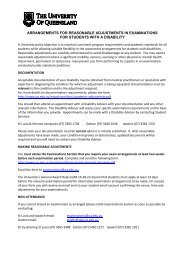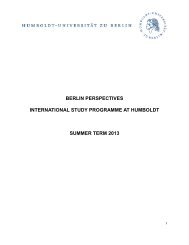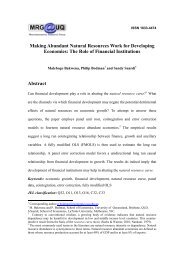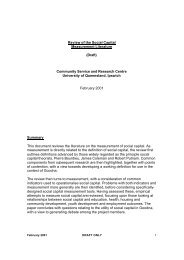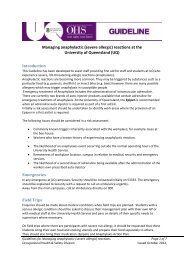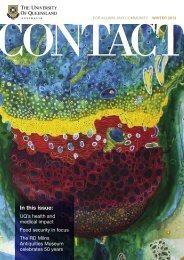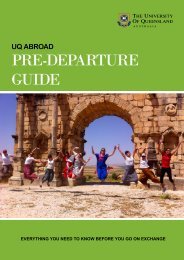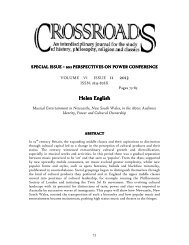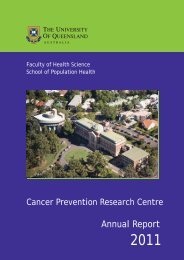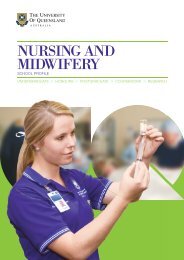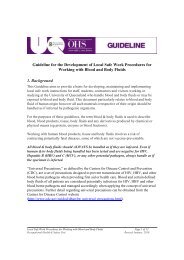Blood and - University of Queensland
Blood and - University of Queensland
Blood and - University of Queensland
Create successful ePaper yourself
Turn your PDF publications into a flip-book with our unique Google optimized e-Paper software.
Risk Assessment <strong>and</strong> TrainingEach department/school/centre is responsible for ensuring the safety <strong>of</strong> staff, students, contractors <strong>and</strong> visitorsby maintaining an ongoing <strong>and</strong> appropriate risk identification <strong>and</strong> management process, which includes thefollowing:Identifying the tasks in which potentially infectious material is h<strong>and</strong>led;Assessing the associated risks;Applying local safe work instructions <strong>and</strong> procedures which result in theMinimisation <strong>of</strong> the risk involved;Implementing the relevant immunisation requirements;Ensuring personal hygiene is appropriate;Inducting new staff, students <strong>and</strong> contractors as well as visitors to the area to ensure they are familiar<strong>and</strong> compliant with the above;Informing all female employees or pregnant woman <strong>of</strong> the risk to the unborn child <strong>of</strong> occupationalexposure to certain microorganisms such as Toxoplasma gondii, Listeria monocytogenes, Coxiella burnetii,rubella <strong>and</strong> hepatitis B, C <strong>and</strong> E viruses.Risk assessment <strong>and</strong> management should be carried out using the UQ Risk Assessment Database at:http://www.uq.edu.au/ohs/index.html?page=29960The following types <strong>of</strong> incidents must be specifically addressed in safe local work instructions: Introduction <strong>of</strong> blood, blood products, tissue or body fluids through the skin or onto mucosal surfaces (eg.Inside mouth, nose or onto eyes); Reporting <strong>of</strong> any “near miss” incidents onto mucosal surfaces (eg. inside mouth, nose <strong>and</strong> into the eye, orneedle stick injuries); Splashes to exposed skin including the face.ImmunisationThe <strong>University</strong>’s Immunisation Policy <strong>and</strong> Guideline should be read in detail as those h<strong>and</strong>ling human or animalblood, blood products, tissues <strong>and</strong> body fluids or performing exposure prone invasive procedures are at risk <strong>of</strong>contracting infectious diseases, some <strong>of</strong> which are vaccine-preventable.Staff <strong>and</strong> students should refer to their school or centre’s immunisation requirements. The <strong>University</strong> alsorecognises that many <strong>of</strong> its students <strong>and</strong> staff perform duties or placements in Queensl<strong>and</strong> Government facilities<strong>and</strong> these students <strong>and</strong> staff (<strong>and</strong> the <strong>University</strong>) are obliged to observe the immunisation requirements imposedby the state government. In particular Queensl<strong>and</strong> Health requires that all potentially at risk health care staff <strong>and</strong>visitors (including students) be vaccinated against hepatitis B. The <strong>University</strong> <strong>of</strong> Queensl<strong>and</strong> adopts <strong>and</strong> complieswith Queensl<strong>and</strong> Health policy in this area.Baseline Serum SampleIt is not recommended that blood samples be taken routinely from new or current staff <strong>and</strong> students for baselineserum levels. However it may be required as a result <strong>of</strong> the outcome <strong>of</strong> a risk assessment <strong>and</strong> the facilitycontainment level involved. Persons working in Physical Containment 3 (PC3) facilities will require healthmonitoring. This may include initial <strong>and</strong> periodic examinations requiring a medical examination, chest X-ray <strong>and</strong>where relevant, a baseline serum sample. Such blood samples must be taken after obtaining informed consent.The sample must be stored securely <strong>and</strong> appropriately bearing in mind the medical <strong>and</strong> legal implicationsinvolved in the subsequent use <strong>of</strong> such specimens.Local Safe Work Procedures for Working with <strong>Blood</strong> <strong>and</strong> Body Fluids Page 2 <strong>of</strong> 8Occupational Health & Safety Division May 2012 , v3.2


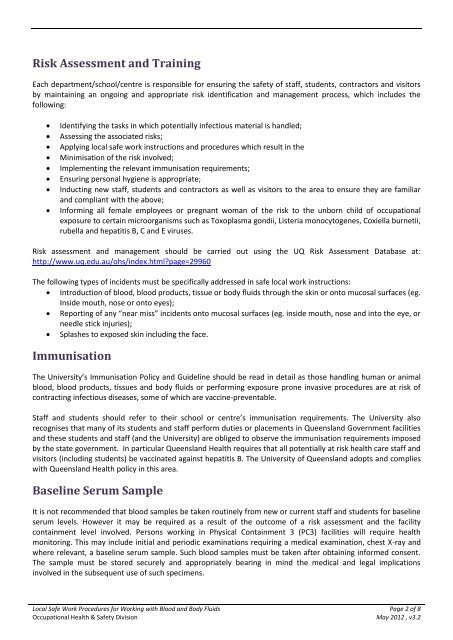

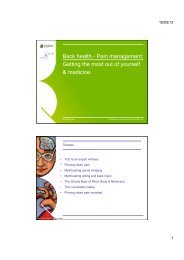
![Recycling [ PDF, 62KB ] - University of Queensland](https://img.yumpu.com/51805185/1/184x260/recycling-pdf-62kb-university-of-queensland.jpg?quality=85)
